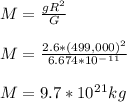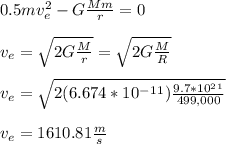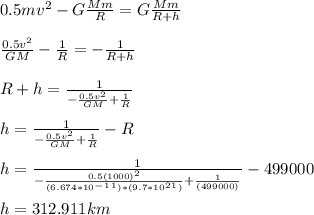
Physics, 08.07.2020 06:01 Lydiaxqueen
Having aced your introductory physics course, you are hired as a summer intern at NASA. You are sent as part of a team to explore the possibility of mining iron from a small, airless spherical asteroid with a radius of 499 km and a surface acceleration of 2.6 m/sec2.
1) What is the mass of the asteroid?
2) What is the minimum vertical velocity you could give a 4 kg rock from the surface of this asteroid so that it continues to move upwards forever (i. e. it would never return to the surface)?
3) What is the minimum vertical velocity you could give an 8 kg rock from the surface of this asteroid so that it continues to move upwards forever (i. e. it would never return to the surface)?
4) How far will the 4 kg rock go if it leaves the asteroid's surface with a vertical velocity of 1000 m/s?
5) What will the speed of the 8 kg rock be at the surface of the asteroid if it is dropped from a point 1000 km above the surface of the asteroid?

Answers: 3


Another question on Physics

Physics, 21.06.2019 12:40
Which of the following energy forms are invovled in a nuclear power plant ? heat ,sound , electrical , nuclear ,mechanical
Answers: 1

Physics, 22.06.2019 02:30
Agas contained within a piston-cylinder assembly undergoes three processes in series: process 12: compression with pv= constant from 1 bar and 1 liter to 4 bar. process 23: constant pressure expansion to 1 liter. process 31: constant volume calculate the pressure and volume at each state, and sketch the processes on a p-vdiagram labeled with pressure and volume values at each numbered stat
Answers: 2


Physics, 22.06.2019 06:30
Air initially at 0.75 bar, 1000 k, and occupying a volume of 0.12 m^3 undergoes two processes. process 1-2: the air is compressed isothermally until the volume is halved. process 2-3: the air undergoes a constant pressure process until the volume is halved again. assume ideal gas behavior. a) determine the mass of the air, in kg. b) the work and the heat transfer for each of the two processes, in kj. (100 kj = 1 bar . m^3)
Answers: 1
You know the right answer?
Having aced your introductory physics course, you are hired as a summer intern at NASA. You are sent...
Questions



History, 26.02.2021 22:40


Mathematics, 26.02.2021 22:40





English, 26.02.2021 22:40


Mathematics, 26.02.2021 22:40



English, 26.02.2021 22:40


Arts, 26.02.2021 22:40



Mathematics, 26.02.2021 22:40






![0 - G\frac{Mm}{( R + h )} = 0.5mv^2 - G\frac{Mm}{ R } \\\\v^2 = 2GM* [ \frac{1}{R} - \frac{1}{R+h} ] \\\\v = \sqrt{2(6.674*10^-^1^1)*(9.70*10^2^1)* [ \frac{1}{499,000} - \frac{1}{1499000}]}\\\\v = 1315.65 \frac{m}{s}](/tpl/images/0702/9900/92f75.png)



